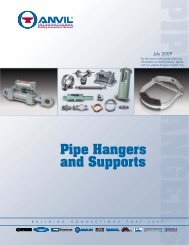Nibco Plastics Catalog - Paramount Supply
Nibco Plastics Catalog - Paramount Supply
Nibco Plastics Catalog - Paramount Supply
Create successful ePaper yourself
Turn your PDF publications into a flip-book with our unique Google optimized e-Paper software.
82<br />
AHEAD OF THE FLOW ®<br />
Applicators<br />
NIBCO INC. WORLD HEADQUARTERS 1516 MIDDLEBURY ST. ELKHART, IN 46516-4740 USA PH: 1.800.234.0227<br />
TECH SERVICES PH: 1.888.446.4226 FAX: 1.888.336.4226 INTERNATIONAL OFFICE PH: +1.574.295.3327 FAX: +1.574.295.3455<br />
www.nibco.com<br />
www.nibco.com<br />
Revised 9/10/2009<br />
Solvent Welding Instructions for ABS, PVC, & CPVC-CTS<br />
Pressure & DWV Piping Systems (Continued)<br />
HOT WEATHER CEMENTING<br />
Since cement contains a solvent, certain precautions or steps<br />
should be taken when the atmospheric temperature is above<br />
90°F, to avoid evaporation of the solvent from the cement just<br />
prior to joining. Such evaporation will cause the cement to prematurely<br />
set before joining, thus, adversely affecting the joint<br />
integrity. Use one or a combination of the list below to reduce<br />
the chances of this condition occurring:<br />
1. Shade or shelter the joint surfaces from direct exposure<br />
to the sun’s rays for at least one hour prior to joining and<br />
during the joining process.<br />
2. Make cement joints during early morning hours.<br />
3. Apply cement quickly. On 6” and larger pipe, it is recommended<br />
that two persons apply cement to pipe sur<br />
face while the third applies it to the fitting socket.<br />
4. Join pipe to fittings as quickly as possible after applying<br />
cement.<br />
COLD WEATHER CEMENTING<br />
Because the solvents in the cement will not evaporate as readily<br />
when the temperature is below 40°F, the pipe joints will not<br />
set up as rapidly in cold weather. If solvent cementing must be<br />
done when the temperature is below 40°F the following suggestions<br />
are offered:<br />
1. Store pipe, fittings, cement and primer in a heated area.<br />
2. Prefab as much of the system as possible in a heated<br />
work area.<br />
3. Joints that must be made outside should be protected<br />
with a portable shelter and heated with indirect heat to<br />
surface temperatures above 40°F prior to joining. The<br />
shelter and heat should remain in place for at least two<br />
hours after joint assembly.<br />
4. Pipe and fittings must be dry prior to joining and the<br />
joints should be kept dry until the cement has had sufficient<br />
time to set.<br />
CAUTION: DO NOT ATTEMPT TO SPEED THE SETTING OR<br />
DRYING OF THE CEMENT BY APPLYING DIRECT HEAT TO<br />
THE SOLVENT WELDED JOINT. Forced rapid drying by heating<br />
will cause the cement solvents to boil off, forming porosity,<br />
bubbles, and blisters in the cement film.<br />
Nominal Size Roller Size Recommended Brush Width*, in.<br />
1/4 1/2<br />
3/8 1/2<br />
1/2 1/2<br />
3/4 1/2<br />
1 Not 1/2<br />
1 1/4 Recommended 1<br />
1 1/2 1<br />
2 1<br />
2 1/2 1 1/2<br />
3 1 1/2<br />
4 3 2<br />
6 3<br />
8 4<br />
10 7 4, 6, or 8<br />
12 4, 6, or 8<br />
*Natural bristle brushes should always be specified. It is recognized that the<br />
recommended brush width may not always be readily available. However,<br />
the selection should come as close as possible to the recommended width<br />
in order to insure complete coverage with a minimum number of brush<br />
strokes.<br />
REQUIREMENTS<br />
The below estimated PVC, CPVC, and ABS IPS pipe solvent<br />
cement requirements should only be considered as a guideline<br />
for usage and could vary according to a wide variety of installation<br />
conditions. Further, these estimates should in no way<br />
be used to restrict the liberal cement application instructions<br />
recommended for the pipe.<br />
Number of Joints Per...*<br />
Nominal Size Pint Quart Gallon<br />
1/2 130 260 1040<br />
3/4 80 160 640<br />
1 70 140 560<br />
1 1/4 50 100 400<br />
1 1/2 35 70 280<br />
2 20 40 160<br />
2 1/2 17 34 136<br />
3 15 30 120<br />
4 10 20 80<br />
5 8 16 64<br />
6 N/R 8 24<br />
8 N/R 3 12<br />
10 N/R N/R 10<br />
12 N/R N/R 6<br />
*Each joint represents one socket in a fitting.<br />
N/R - Not Recommended.



